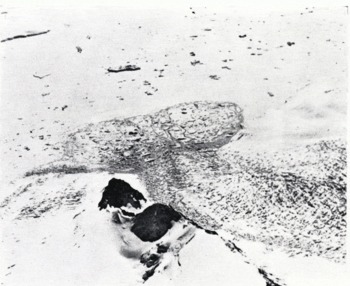Sir,
In describing an ice delta in front of Northeast Glacier near Stonington Island, Marguerite Bay, Antarctic Peninsula, Antarctica, I wrote (Reference Nichols and WashingtonNichols, [1953], p. 88, 92–94, Reference Nichols1960, p. 1442–43):
“The Northeast Glacier has a central zone up and down the glacier which is greatly crevassed. The areas marginal to this zone, however, have only a few narrow crevasses. An area of sea ice everywhere covered with fragments of glacial ice, found in front of the crevassed zone during the cold season, may be called a brash and growler ice delta. It extends from the barrier outward for hundreds of feet and is characterized by an irregular, hummocky topography and by indications of pressure (1960, fig. 12; pl. 4, fig. 4) … . There is no area of broken glacial ice in front of the marginal zones. The brash and growler ice delta formed as follows: Masses of ice fell from the crevassed barrier onto the sea ice, and ice broke off from the glacial toe and floated upward … . During and following this, the glacier continued to move forward and outward, pushing the ice fragments and sea ice in front of it. Later, another mass of ice fell from the barrier. The continuous forward motion of the glacier pushed this ice outward, while the fragments formed earlier were pushed still farther out … . The thrust of the glacier as it moved into the field formed pressure ridges, cracks, and folded bay ice. Where the glacier moved most rapidly, the fragments were pushed farthest out into the bay and the area was widest. The delta was formed, therefore, by a discontinuous collapse of the crevassed barrier and by a rapid, continuous forward motion of the glacier while the barrier remained at essentially the same place.”
I now wonder if this ice delta—and others like it along the Antarctic Peninsula (Fig. 1)—may not be due to a glacial surge. A surge might be responsible if: (1) All the fragments in the delta have suffered about the same amount of ablation and have, therefore, been formed in one season more or less simultaneously; (2) Ice deltas of this size are not formed yearly but only very occasionally; (3) The volume of glacial ice in the ice delta is greater than that which could be supplied by the normal yearly forward motion of the glacier. If ice deltas are found in front of every tide-water glacier, not all of them can be due to surges, as it is most unlikely that all glaciers would surge simultaneously. In general, the larger the delta, the more likely that it is due to a surge. It would be interesting to know if these deltas are associated with glaciers which are characterized by contorted moraines, excessively broken and crevassed ice, and lowered surfaces in their headward areas.

Fig. 1. Aerial photograph showing a crevassed glacier and its ice delta, Antarctic Peninsula, Antarctica.
18 January 1973





